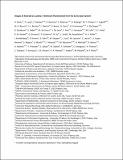Images of Asteroid 21 Lutetia: A Remnant Planetesimal from the Early Solar System
Author(s)
Weiss, Benjamin P.
DownloadSierks_2011_open_access.pdf (1.319Mb)
OPEN_ACCESS_POLICY
Open Access Policy
Creative Commons Attribution-Noncommercial-Share Alike
Terms of use
Metadata
Show full item recordAbstract
Images obtained by the Optical, Spectroscopic, and Infrared Remote Imaging System (OSIRIS) cameras onboard the Rosetta spacecraft reveal that asteroid 21 Lutetia has a complex geology and one of the highest asteroid densities measured so far, 3.4 ± 0.3 grams per cubic centimeter. The north pole region is covered by a thick layer of regolith, which is seen to flow in major landslides associated with albedo variation. Its geologically complex surface, ancient surface age, and high density suggest that Lutetia is most likely a primordial planetesimal. This contrasts with smaller asteroids visited by previous spacecraft, which are probably shattered bodies, fragments of larger parents, or reaccumulated rubble piles.
Date issued
2011-04Department
Massachusetts Institute of Technology. Department of Earth, Atmospheric, and Planetary SciencesJournal
Science
Publisher
American Association for the Advancement of Science (AAAS)
Citation
Sierks, H. et al. “Images of Asteroid 21 Lutetia: A Remnant Planetesimal from the Early Solar System.” Science 334.6055 (2011): 487–490.
Version: Author's final manuscript
ISSN
0036-8075
1095-9203